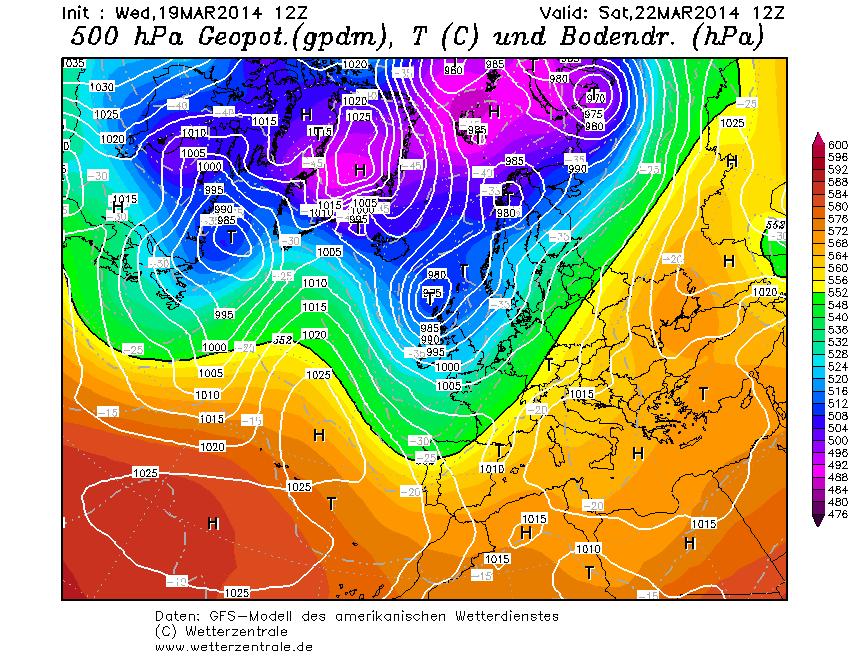Der WetterBlog freut sich heute über die Erfolge der modernen Wissenschaft. Als Student im fortgeschritteneren Stadium fragt man sich ja schon gelegentlich, warum man eigentlich das tut, was man tut und wem das was bringen soll. Die Sinnhaftigkeit der eigenen Doktor- oder Masterarbeit im speziellen mag zu bezweifeln sein, aber gelegentlich gelingt der Wissenschaft im allgemeinen etwas Cooles und dann hat man das Gefühl, dass doch irgendwie und ganz generell irgendwas richtig läuft.
Die große Meldung der letzten Tag war in diesem Sinne das hier:
Let me play among the stars
Das Bild stammt von einem Teleskop in der Antarktis namens Background Imaging of Cosmic Extragalactic Polarization 2 (BICEP2). Damit wird seit ein paar Jahren im Mikrowellenbereich ins Weltall geschaut, um die kosmische Hintergrundstrahlung zu untersuchen und um vielleicht, irgendwann, eine Polarisierung der Strahlung zu finden, weil das ein starker Hinweis auf die Existenz von Gravitationswellen wäre. Einsteins allgemeine Relativitätstheorie besagt (in etwa), dass die Raumzeit eine Art Pudding ist, der schwabbelt, wenn man kräftig genug mit einem Löffel drauf haut. Dieses Schwabbeln sind die Gravitationswellen. (Schwerewellen sind etwas anderes und für das Wetter wesentlich relevanter, siehe Leewellen und die folgenden Wolken. Auf Englisch unterscheidet man gravitational waves und gravity waves.)
BICEP2 hat nun genau das gefunden, was man sich von ihm erhofft hat und zwar auf eine so deutliche Weise, dass die beteiligten Forscher den Daten erst gar nicht glauben wollten und vor der Veröffentlichung mehrere Jahre überlegt haben, ob das wirklich stimmen könnte. (Die zwei entsprechenden wissenschaftlichen Publikationen gibt es hier, für sehr motivierte.) Die Leute, die 1978 den Nobelpreis für die Entdeckung der kosmischen Hintergrundstrahlung bekamen, dachten übrigens zunächst, sie hätten falsch gemessen, weil Tauben auf ihre Instrumente gekackt hatten. Die Entdeckung von BICEP2 muss freilich erst überprüft und auch von anderen Menschen und Instrumenten gefunden werden, aber soweit ist man wohl zuversichtlich, dass keine Pinguine oder Tauben im Spiel waren. Hier noch ein nettes Video, das zeigt wie einer der jungen Forscher des BICEP2 Projekts einem älteren Professor, der seit 30 Jahren an dem Thema arbeitet, die frohe Botschaft überbringt.
Ein direkter Beweis für den schwabbelnden Pudding würde bedeuten, dass man die Ursprünge des Universums ein gutes Stück besser versteht, dass am Anfang wohl tatsächlich der Urknall knallte und dass sich das Universum wirklich ausdehnt. Daraus ergibt sich allerhand Potential für komplizierte Überlegungen, wie etwa die Zusammenführung der Gravitations- und der Quantentheorie. Der WetterBlog gibt nicht vor, das alles zu verstehen, aber cool findet er es trotzdem.
Let me see what spring is like on (Jupiter and) Mars
Kommen wir langsam zum Wetter, beziehungsweise dem Frühling. Die NASA hat kürzlich ein Bild veröffentlicht, dass im Januar aufgenommen wurde und zeigt, wie auf dem Mars die Südhänge ausapern.
Das, was hier schmilzt ist kein Schnee, sondern gefrorenes Kohlendioxid, auch bekannt als Trockeneis. Auf dem Mars wird es im Winter so kalt, dass um die 25% des atmosphärischen CO2s sublimieren und eine saisonale „Schneedecke“ bilden.
Man fragt sich, wie sich sowas wohl fährt. Interessantes Gelände wäre schonmal vorhanden:
Mehr Informationen und Videos von mehr Gelände.
Nett findet der WetterBlog heute auch die Möglichkeit den Nordpol des Mondes von der Couch aus in zwei Meter Auflösung zu betrachten, weil sich jemand die Mühe gemacht hat, 10581 Bilder von Kameras auf einem Mondsatelliten der NASA zusammen zu setzen. Volle Auflösung mit zoom und pan Möglichkeit.
Und auf der Erde?
In den Alpen? Sturm und Nordföhn am letzten Wochenende, frühsommerliche Temperaturen, schwindender Schnee überall, stellenweise brennt der Wald. Bunte Karten, eine lange Kaltfront und große Aufregung für das nächste Wochenende. Der Westen und der Süden kriegen nochmal ordentlich was ab, sonst hält sich das ganze in Grenzen, ganz nach bekannter 2014er-Tradition. Für die kommende Woche sind sich die Modelle noch sehr uneinig. Das eine sieht mildes Vorderseitenwetter, das andere hingegen ein abgetropftes Italientief mit interessanten Niederschlagsoptionen. Was draus wird, sagt uns im Fall des Falles sicherlich Kollege Orakel. Der Wetterblog träumt derweil weiter von den Sternen.










